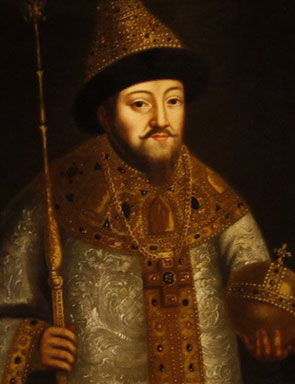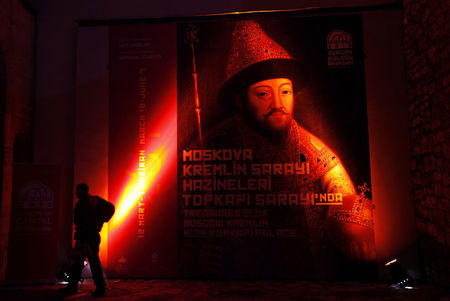“Kremlin Palace Treasures are in the Topkapı Palace”
A portrait of Tsar Mikhail Fedorovich is displayed at the "Treasures of the Moscow Kremlin at the Topkapi Palace" exhibition at the Ottoman era Topkapi Palace in Istanbul. REUTERS/Murad Sezer.
ISTANBUL.- The Topkapı Palace which has been the center of the state administration for nearly four centuries of the Ottoman Empire, is preparing to host the masterpieces of the Kremlin Palace. The exhibition that is named “Kremlin Palace Treasures are in the Topkapı Palace” is inviting all residents of Istanbul to be witnesses of the great meeting of the two palaces.
The exhibition which will be realized within the activities of the Cultural Heritage and Museums Directorate of the Istanbul 2010 European Capital of Culture Agency is going to meet with the art-lovers on Friday the 12th, March 2010 at the Privy Stables section of the Topkapı Palace.
After the “Ten Thousand Years of Iranian Civilization, Two Thousand Years of Common Heritage” exhibition that was financially supported by the Istanbul 2010 European Capital of Culture Agency, this second exhibition was formed with the objects that belong to the 16th-17th centuries, peace period between the Ottoman and the Russia. Approximately one hundred objects that handle the czars with their different courses including the head of state, army commander, palace ceremonies, private lives and religious sides will display in the exhibition.
In the armory which is one of the first workshops of the Kremlin Palace in Moscow, which is still being operated as Armory Museum, which including the weapons that produced for the czar to be used in ceremonies, battles and hunts. In the Superiority of Stables, the objects including ceremonial harnesses for the horses, the things for the usage of czars in their private and common lives that produced by the masters which worked in the workshops of gold and silver and coverings and clothing sewn and ornamented with pearls and silver threads for both the religious and casual usage by the master tailors and embroiderers most of them are the daughters of noble Russian families under in custody of the czarina in the Chamber of Czarina also takes their places there.
It is known that the weaves, which were imported from the Ottoman lands in 16th and 17th centuries, weapons, harnesses and golden breweries were being registered at the private inventory of the chamber of external affairs that the most valuable ones of which were being separated for the state treasury that was being used in some of the principal functions of the official and casual life of Palace. And some of them were being used properly with domestic conditions. It is also known that in the 16th century, the Cavalry Units of Russian Army were being equipped with the Ottoman weapons and amours also the harnesses of the Ottoman army used with appreciation by Russians. It has also been valued that Ottoman fabrics were being transformed into casual and religious clothing; interior place coverings and as well Ottoman fabrics were used at the surface coatings of the horse blankets, saddles, coats of scabbards and in the interior surface coatings of the shields and in the armbands of amours. The pieces forming the little part of the Turkish art collection including the weapons as swords, helmets, daggers and pieces, which are harnesses, breweries pocket watches, basins, ewers, ink-holders joining to the inventories of Kremlin Palace pursuant to the diplomatic relations between two countries is meeting with the visitors at the place that they were produced first in Istanbul.
A visitor walks past a poster of the "Treasures of the Moscow Kremlin at the Topkapi Palace" exhibition at the Ottoman era Topkapi Palace in Istanbul March 11, 2010. Treasures from Moscow's Kremlin Palace will be on display at the Topkapi Palace in association with the Kremlin Museum until June 7. The exhibition includes works of art from the 16th and 17th centuries and is a part of "Istanbul European Capital of Culture of 2010" activities. REUTERS/Murad Sezer.

/https%3A%2F%2Fprofilepics.canalblog.com%2Fprofilepics%2F1%2F0%2F100183.jpg)
/https%3A%2F%2Fstorage.canalblog.com%2F03%2F02%2F119589%2F96711876_o.jpg)
/https%3A%2F%2Fstorage.canalblog.com%2F11%2F31%2F119589%2F94773502_o.jpg)
/https%3A%2F%2Fstorage.canalblog.com%2F20%2F83%2F119589%2F94772815_o.jpg)
/https%3A%2F%2Fstorage.canalblog.com%2F26%2F72%2F119589%2F75604929_o.jpg)
/https%3A%2F%2Fstorage.canalblog.com%2F59%2F60%2F119589%2F26458628_o.jpg)




/image%2F1371349%2F20240425%2Fob_c453b7_439605604-1657274835042529-47869416345.jpg)
/image%2F1371349%2F20240425%2Fob_59c6f0_440358655-1657722021664477-71089985267.jpg)
/image%2F1371349%2F20240425%2Fob_07a28e_440353390-1657720444997968-29046181244.jpg)
/image%2F1371349%2F20240425%2Fob_0b83fb_440387817-1657715464998466-20094023921.jpg)